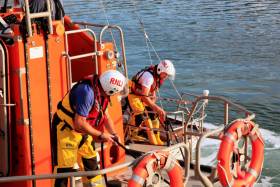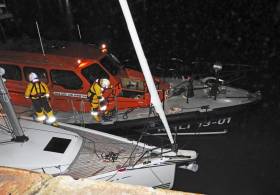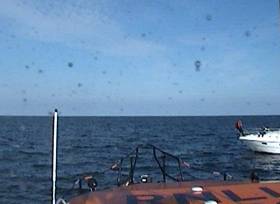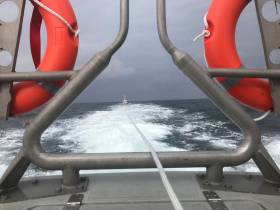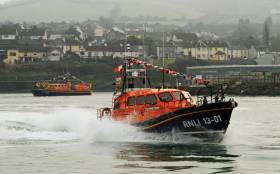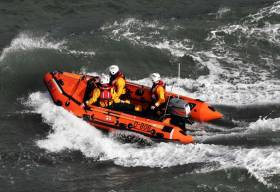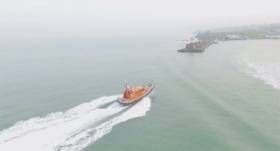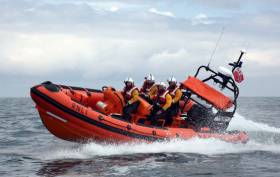Displaying items by tag: Wicklow
Wicklow RNLI’s all-weather lifeboat Jock & Annie Slater went to the assistance of two sailors yesterday evening (Saturday 27 July) after their vessel developed engine failure.
The lifeboat put to sea under the command of Deputy Coxswain Tommy McAulay, and was alongside the drifting 28ft yacht at 5.50pm, eight miles north-east of Wicklow Harbour.
Conditions at the scene were calm with good visibility. A tow line was quickly established, and the stricken yacht was towed back to Wicklow Harbour where it was brought alongside the East Pier at 7.30pm and the two sailors were landed safely ashore.
The crew on the callout were Tommy McAulay, mechanic Tommy Murphy, Brendan Copeland, Brendan Kavanagh, Graham Fitzgerald and John Stapleton.
Wicklow RNLI’s all-weather lifeboat brought three sailors to safety early on Friday morning (14 June) after their 35ft yacht got into difficulty nine miles east of Wicklow Harbour.
The lifeboat slipped moorings shortly after 1am and put to sea following a pager alert from the Irish Coast Guard.
The alarm was raised after the yacht which was on passage south to Cork got fouled in ropes and lost propulsion.
The Shannon class lifeboat Jock and Annie Slater was alongside the stricken yacht at 1,35am six miles east of Wicklow Head.
Volunteer crew members David O’Leary and Paul Sillery were transferred onto the yacht and managed to free the ropes from the propeller.
Weather conditions on scene had a sea state slight with wind southwest Force 2.
A towline was established, and the yacht was towed back to Wicklow Harbour where the three sailors were landed safely ashore and the yacht was secured alongside the East Pier by 3.30am.
The incident came just days after a 10m yacht with three on board was fouled on ropes off Wicklow Head, as previously reported on Afloat.ie.
Wicklow Lifeboat Assists Yacht With Rope-Fouled Rudder
Wicklow RNLI brought three sailors to safety yesterday morning (Sunday 9 June) after their 10-metre yacht got fouled in ropes off Wicklow Head.
The all-weather lifeboat Jock and Annie Slater put to sea shortly before 10am under the command of coxswain Nick Keogh, following a launch request from the Irish Coast Guard.
The yacht, with three people on board, was located at 10.12am about two-and-a-half miles south-east of Wicklow Head. Conditions on scene had a slight sea state and good visibility.
Lifeboat volunteer Alan Goucher was transferred onto the yacht to assess the situation and assist with the towline.
The yacht was taken in tow back to Wicklow Harbour and brought safely alongside the East Pier at 11.10am.
Wicklow RNLI’s new relief Shannon class lifeboat Jock and Annie Slater has had its fifth callout since going on station over a month ago to assist a motor cruiser with engine failure.
The all-weather lifeboat slipped her moorings at 4.50pm on Tuesday afternoon (7 May) to aid the 12-metre cruiser with eight people on board, which had set out from Wales and was crossing the Irish Sea to Malahide when it developed mechanical problems and lost all propulsion.
The skipper contacted the coastguard by marine VHF radio for assistance.
Wicklow’s lifeboat was alongside the casualty at 5.45pm about 19 miles offshore. Conditions in the area had a south-east Force 2 with a slight sea state and good visibility.
A tow line was established and the motor cruiser was taken in tow back to Wicklow Harbour where it was bought alongside the East Pier and all eight on board landed safely ashore.
Wicklow Lifeboat Assists Fishing Vessel With Engine Failure
Wicklow RNLI volunteers were alerted by pager at 1.05pm on Friday afternoon (12 April) following a launch request to assist a fishing boat with engine failure.
The all-weather lifeboat Jock and Annie Slater put to sea shortly before 1.15pm under the command of coxswain Nick Keogh and proceeded towards the vessel, which was reported to be 23 miles north-east of Wicklow Harbour.
The lifeboat was alongside the 10-metre fishing boat an hour later. Conditions in the area were good, with south-easterly Force 3 winds.
The fishing vessel with three crew had developed mechanical problems and had lost propulsion. A towline was secured, and the vessel was towed back towards Wicklow over the next three-and-a-half hours, being secured safely alongside the North Quay shortly before 6pm.
This was the third callout since the all-weather lifeboat Jock and Annie Slater went on station at Wicklow on Friday 5 April.
Earlier in the week, Kilkeel RNLI’s volunteer crew launched at 4.20pm on Wednesday (10 April) to respond to a call from the skipper of a fishing boat that a semi-submerged kayak was adrift at Leestone Point, north east of Kilkeel Harbour.
Conditions were good and the crew arrived quickly on scene. On examination of the kayak, the crew found there was an algae growth on her bottom and no signs that it had been recently occupied.
With no reports of a missing kayaker, the kayak was taken on board the lifeboat which then returned to the station. Kilkeel Coastguard were in attendance.
Speaking afterwards, John Fisher, Kilkeel RNLI lifeboat operations manager, said: “It is important that if a small craft is lost or abandoned that it is reported to the coastguard. This will prevent any further reports by concerned members of the public or other persons.”
First Callout For Wicklow’s Relief Shannon Class Lifeboat
Wicklow RNLI’s relief Shannon class lifeboat Jock and Annie Slater has its first callout yesterday morning (Tuesday 9 April) to go to the aid of a whelk-fishing vessel with engine failure.
The lifeboat, under the command of second coxswain Ciaran Doyle, located the drifting vessel two miles east of Kilcoole at 11.10am.
Weather conditions in the area at the time had an easterly Force 5 with moderate sea.
A towline was quickly established, and the trawler was taken in tow. The fishing vessel and three crew were brought safely alongside the South Quay in Wicklow Harbour shortly after 12.30pm.
This was the first callout for the Shannon class lifeboat which went on station last Friday.
It comes during a very busy period at Wicklow RNLI as Jock and Annie Slater replaced Annie Blaker, the last Tyne class lifeboat in the RNLI fleet, which was officially retired last Friday 4 April after 30 years of service with Wicklow lifeboat station.
The slipway-launched lifeboat has been the busiest all-weather lifeboat in the history of the station — being involved in over 340 services, and rescuing over 400 people, since her arrival in 1989.
The final callout for Annie Blaker came last Thursday evening (3 April) when coxswain Nick Keogh and a volunteer crew launched to assist two sailors on a yacht with a rope-fouled propeller nine miles off the Wicklow coast.
Annie Blaker has been replaced by the relief lifeboat Jock and Annie Slater, which will operate from temporary facilities at the South Quay while the slipway and station are redeveloped to accommodate a new permanent lifeboat, which is expected to arrive in 2022.
Wicklow RNLI operations manager Des Davit said: “This month will be bittersweet for all of us involved in Wicklow Lifeboat Station. We will be saying goodbye to a magnificent boat, the last Tyne in the fleet, the Annie Blaker.
“At the same time, thanks to a magnificent effort of skill, determination and commitment by the crew just one month after her arrival, Lifeboat 13-01, the Jock and Annie Slater, went on service.
“Because of the skill of the crew and their huge commitment to training this new, state of the art lifeboat went on service much earlier than anticipated.
“We hope to have a farewell party for ‘Annie’ later in the month so keep an eye out for more information on this both in the press and on social media.”
In other news, BT Ireland, operator of the national 999/112 emergency call answering service, has donated €5,000 to the RNLI.
Bundoran, Rosslare and Courtmacsherry RNLI each received donations through BT Ireland’s nationwide payroll giving scheme ‘Give As You Earn’ to support their vital services in the community.
Captain Tony McGowan, Bundoran RNLI lifeboat operations manager, said: “This is a huge donation that will help our lifeboat crews continue to save lives at sea.
“These funds will help to ensure our crews are fully kitted, trained and skilled to do the work that they do and that our lifeboat is equipped, fuelled and maintained.”
Wicklow Lifeboat Launched To Search For Missing Dog
Wicklow RNLI's inshore lifeboat was launched at 4:40pm yesterday afternoon (Friday 8 March) to search for a missing dog.
The alarm was raised by the anxious owner after her dog, named Otis, chased some seagulls down over the cliff edge at Wicklow Head and disappeared.
The lifeboat — with helm Graham Fitzgerald and crew Ian Thompson and John Stapleton — was on scene eight minutes after launching and the crew began a sweep of caves and the shoreline at a location known as the Pond, near Wicklow Head lighthouse.
During the search the dog could be heard barking from a cave, so crew member Stapleton was put ashore near the opening and, with some persuading, the dog was coaxed out to climb back up the cliff and into the arms of his grateful owner.
Elsewhere, a young man was recovered from the River Corrib by members of the emergency services in Galway in the early hours of Friday morning following a major rescue operation involving the Galway RNLI lifeboat.
The man has got into difficulty in a canal beside the river around 3.30am, and during the rescue both the casualty and rescue personnel ended up entering the fast-flowing Corrib towards the Spanish Arch, where the casualty was recovered for transfer to Galway University Hospital.
Mike Swan, Galway RNLI lifeboat operations manager, said: “We would encourage all members of the public to respect the water at all times regardless of their activity.
“Be wary of all edges around the sea and watersides. Slips and falls happen in all locations.”
Watch Spectacular Drone Video Of Relief Lifeboat Arriving In Wicklow
#Lifeboats - Skycam Ireland has released some breathtaking drone video from the arrival of the relief Shannon class lifeboat Jock and Annie Slater in Wicklow on Sunday afternoon (24 February) after travelling from RNLI headquarters in Poole, Dorset.
A large turnout of family, friends and supporters gathered as the Wicklow all-weather lifeboat Annie Blaker and the inshore lifeboat escorted the relief Shannon into the harbour, while a lone piper on the East Pier played a musical tribute to signal the arrival.
Staff Coxswain Pete Hanscombe accompanied the crew on the training passage, but Coxswain Nick Keogh had the honour of bringing the relief Shannon into Wicklow harbour. A short impressive display of the boats speed and agility was greeted with applause from the crowd, before it came alongside the pier.
As previously reported on Afloat.ie, the relief Shannon class will replace the last remaining Tyne class lifeboat in active service — and the busiest in the history of Wicklow RNLI — when it is retired in the next few months.
 The relief Shannon lifeboat Jock and Annie Slater arriving at Wicklow on Sunday 24 February | Photo: RNLI/Wicklow
The relief Shannon lifeboat Jock and Annie Slater arriving at Wicklow on Sunday 24 February | Photo: RNLI/Wicklow
Kilkeel Lifeboat Responds To Early-Hours Mayday From Fishing Vessel Crew
#Lifeboats - Kilkeel’s RNLI volunteers responded to a Mayday in the early hours of yesterday morning (Sunday 24 February) after a fishing vessel lost propulsion about half a mile off Kilkeel Harbour in very foggy conditions.
The crew, including helm Gerry Smyth, Andrew McConnell, Mark McCullough and Robert Tomkins, launched their inshore lifeboat and responded to the Mayday call at 5.40am.
The vessel was quickly located and having spoken to the skipper, the helm decided to put crew member Andrew McConnell aboard to safely secure a tow rope and safely tow in the vessel, with the local coastguard team assisting in berthing. By 6.25am the crew had returned safely to the boathouse.
Speaking following the call-out, Kilkeel RNLI helm Gerry Smyth said it was “something our volunteers train for on a regular basis but this time the foggy conditions and the low tide made the tow more difficult than usual.
“The lifeboat crew were delighted to help and handled the call out in a thoroughly professional manner. We wish the fishermen well.”
Lifeboat Changes At Wicklow RNLI Signal Major Investment In Historic Station
#Lifeboats - As noted by Tom MacSweeney in his latest podcast, Wicklow is the last RNLI station with a Tyne class lifeboat in service.
Before the current Tyne lifeboat Annie Blaker is officially taken off service later this year, it will be replaced by a relief Shannon class lifeboat — the fastest and most technologically advanced class in the fleet.
The Shannon class Jock and Annie Slater is due to arrive in Wicklow on Sunday 24 February at 2:30pm.
Annie Blaker has been the busiest all-weather lifeboat in the history of the station, being involved in over 340 services, rescuing over 400 people.
It will be a bittersweet time for the crew, station management and fundraisers with the arrival of the new lifeboat and the departure of Annie.
The relief lifeboat, which will eventually be replaced by a permanent Shannon for Wicklow in a few years’ time, will have a temporary berth at the South Quay.
Each lifeboat class has a unique slip to launch from and as the Shannon is very different to the Tyne class, this temporary mooring near the station will support it until Wicklow receives its permanent Shannon lifeboat.
Work will need to be undertaken to support the changes at Wicklow and this will be undertaken in full consultation with relevant stakeholders.
Commenting on the changes, Wicklow RNLI lifeboat operations manager Des Davitt said: “The confidence displayed by the RNLI Council and trustees, who have given the go-ahead for this major investment, is a testament to the service of all crew, committees and fundraising teams, past and present.
“History is in the making as the newest, fastest, state-of-the-art lifeboat is about to arrive. Already our coxswains and mechanics have attended training in Poole and a crew from our station has been tasked with bringing the Shannon class lifeboat into Wicklow on Sunday 24 February where the rest of the crew will receive training from the fleet staff coxswains.
“Over the next three years major work will be carried out on the station and slip to accommodate the arrival of our own Shannon in early 2022. None of this would be possible without the magnificent support of the people, businesses and organisations of Wicklow and environs.
“It is an exciting time for all involved and indeed for the people of Wicklow.”



























